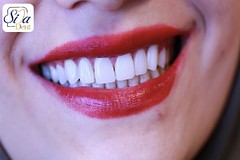
Dentistry and Maxillo-Facial Surgery
by
magnus
Our skilled team at the Department of Dentistry and Maxillofacial surgery includes pediatric dentists, orthodontists, endodontics, oral and maxillofacial surgery, prosthodontics and periodontics. The department has been catering to the dental needs of its patients since its inception. Our services are rendered to children, teens, adults and even patients with special health care needs. From common pediatric conditions like chipped tooth and overbites to more complex surgical treatments, our team of experts are equipped with years of experience to handle anything, with utmost care. Backed by a post-op rehabilitation and care team, the Department of Dentistry and Maxillofacial surgery has delivered millions of smiles over the years.
Dental implant surgery
Dental implant surgery is a procedure that replaces tooth roots with metal, screw-like posts and replaces damaged or missing teeth with artificial teeth that look and function much like real ones. Dental implant surgery can offer a welcome alternative to dentures or bridgework that doesnt fit well.
How dental implant surgery is performed depends on the type of implant and the condition of your jawbone. But all dental implant surgery occurs in stages and may involve several procedures. The major benefit of implants is solid support for your new teeth ” a process that requires the bone to heal tightly around the implant. Because this healing requires time, the process can take many months.
DSC_0324
Why its done
Dental implants are surgically placed in your jawbone, where they serve as the roots of missing teeth. Because the titanium in the implants fused with your jawbone, the implants wont slip, make noise or cause bone damage the way fixed bridgework or dentures might. And the materials cant decay like your own teeth that support regular bridgework can.
In general, dental implants may be right for you if you:
Have one or more missing teeth
Have a jawbone thats reached full growth
Have adequate bone to secure the implants or are able to have a bone graft
Have healthy oral tissues
Dont have health conditions that will affect bone healing
Are unable or unwilling to wear dentures
Want to improve your speech
Are willing to commit several months to the process
Risks
Like any surgery, dental implant surgery poses some health risks. Problems are rare, though, and when they do occur theyre usually minor and easily treated. Risks include:
[youtube]http://www.youtube.com/watch?v=uZR3dx3iq5o[/youtube]
Infection at the implant site
Injury or damage to surrounding structures, such as other teeth or blood vessels
Nerve damage, which can cause pain, numbness or tingling in your natural teeth, gums, lips or chin
Sinus problems, when dental implants placed in the upper jaw protrude into one of your sinus cavities
How you prepare
Because dental implants require one or more surgical procedures, you must have a thorough evaluation to prepare for the process, including a:
Comprehensive dental exam. You may have dental X-rays taken and models made of your teeth and mouth.
Treatment plan. Tailored to your situation, this plan takes into account factors such as how many teeth you need replaced and the condition of your jawbone. The planning process may involve a variety of dental specialists, including a doctor who specializes in conditions of the mouth, jaw and face (oral and maxillofacial surgeon) and a dentist who works with the structures that support teeth (periodontist).
Tell your doctor about any medical conditions and any medications you take, including prescription and over-the-counter drugs and supplements. If you have certain heart conditions or orthopedic implants, your doctor may prescribe antibiotics before surgery to help prevent infection.
To control pain, anesthesia options during surgery include local anesthesia, sedation or general anesthesia. Talk to your dental specialist about which option is best for you. Your dental care team will instruct you about eating and drinking before surgery, depending on what type of anesthesia you have. If youre having general anesthesia, plan to have someone take you home after surgery and expect to rest for the remainder of the day.
What you can expect
Dental implant surgery is usually an outpatient surgery performed in stages:
Your damaged tooth is removed.
Your jawbone is prepared for surgery, a process that may involve bone grafting.
After your jawbone heals, your oral surgeon places the dental implant metal post in your jawbone.
You go through a healing period that may last several months.
Your oral surgeon places the abutment ” an extension of the implant metal post ” followed by your new artificial tooth (crown).
The entire process can take many months from start to finish ” three to nine months and sometimes longer. Much of that time is devoted to healing and waiting for the growth of new bone in your jaw.
When bone grafting is required
If your jawbone isnt thick enough or is too soft, you may need bone grafting before you can have dental implant surgery. Thats because the powerful chewing action of your mouth exerts great pressure on your bone, and if it cant support the implant, the surgery likely would fail. A bone graft can create a more solid base for the implant.
With bone grafting, a piece of bone is removed from another part of your jaw or your body ” your hip, for example ” and transplanted to your jawbone. It may take up to nine months for the transplanted bone to grow enough new bone to support a dental implant. In some cases, you may need only minor bone grafting, which can be done at the same time as the implant surgery. The condition of your jawbone determines how you proceed.
Placing the dental implant
During surgery to place the dental implant, your oral surgeon makes a cut to open your gum and expose the bone. Holes are drilled into the bone where the dental implant metal post will be placed. Since the post will serve as the tooth root, its implanted deep into the bone.
At this point, youll still have a gap where your tooth is missing. Usually, a type of partial, temporary denture can be placed for appearance. You can remove this denture for cleaning and while you sleep.
Waiting for bone growth
Once the metal implant post is placed in your jawbone, osseointegration begins. During this process, the jawbone grows into and unites with the surface of the dental implant. This process, which can take up to six months, helps provide a solid base for your new artificial tooth ” just as roots do for your natural teeth.
Placing the abutment
When osseointegration is complete, you may need additional surgery to place the abutment ” the piece where the crown will eventually attach. This minor surgery is typically done with local anesthesia in an outpatient setting.
To place the abutment:
Your oral surgeon reopens your gum to expose the dental implant
The abutment is attached to the dental implant
The gum tissue is then closed around, but not over, the abutment
In many cases, the abutment is attached to the dental implant metal post when the post is implanted. That means you wont need an extra surgical step. Because the abutment juts past the gumline, however, its visible when you open your mouth ” and it will be that way until your dentist completes the tooth prosthesis. Some people dont like that appearance and prefer to have the abutment placed in a separate procedure.
Choosing your new artificial teeth
After the abutment is placed, your gums must heal for one or two weeks before the artificial tooth can be attached. Once your gums heal, youll have more impressions made of your mouth and remaining teeth. These impressions are used to make the crown ” your realistic-looking artificial tooth. The crown cant be placed until your jawbone is strong enough to support use of the new tooth.
You and your dental specialist can choose from two main types of artificial teeth:
A removable implant prosthesis. This type is similar to a conventional removable denture. It contains artificial white teeth surrounded by pink plastic gum. Its mounted on a metal frame thats attached to the implant abutment, and it snaps securely into place. It can be easily removed for repair or daily cleaning. Its often a good choice when several teeth in the lower jaw are replaced, mainly because its more affordable than multiple individual dental implants and yet more secure than a traditional denture.
A fixed implant prosthesis. In this type, an artificial tooth is permanently screwed or cemented onto an individual implant abutment. You cant remove the tooth for cleaning or during sleep. If affordability isnt a concern, you can opt to replace several missing teeth this way. Each crown is attached to its own dental implant.
After surgery
Whether you have dental implant surgery in one stage or multiple stages, you may experience some of the typical discomforts associated with any type of dental surgery, such as:
Swelling of your gums and face
Bruising of your skin and gums
Pain at the implant site
Minor bleeding
Results
Most dental implants are successful. Sometimes, however, the bone fails to fuse sufficiently to the metal implant. Smoking, for example, can contribute to implant failure and complications.
If the bone fails to fuse sufficiently, the implant is removed, the bone is cleaned up, and you can try the procedure again in a month or two.
You can help your dental work ” and remaining natural teeth ” last longer if you:
Practice excellent oral hygiene. Just as with your natural teeth, you must keep implants, artificial teeth and gum tissue clean. Specially designed brushes, such as an inter dental brush that slides between teeth, can help clean the nooks and crannies around teeth, gums and metal posts.
See your dentist regularly. Schedule dental checkups every six months to one year to ensure the health and proper functioning of your implants.
Avoid damaging habits. Dont chew hard items, such as ice and hard candy, which can break your crowns ” or your natural teeth. Avoid tooth-staining tobacco and caffeine products. Get treatment if you grind your teeth.
Get multiple opinion & quotes for Treatment in India, Multiple Opinion will help you take the right and informed decision. We will help you plan your medical tour Local Transportation, Internet Enabled SIM Card, Tickets, Accommodation, Forex services, and anything else you might need.
Fortishealthcare
Article Source:
eArticlesOnline.com }






